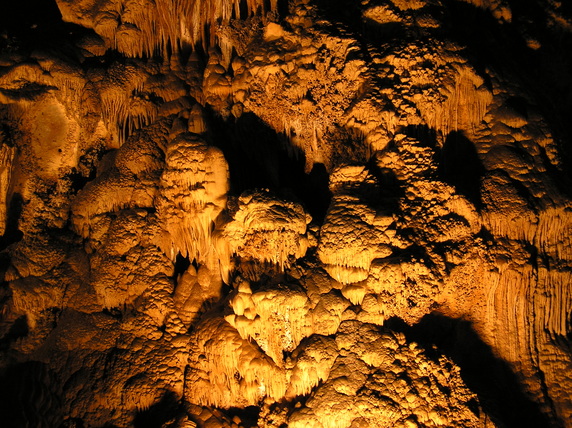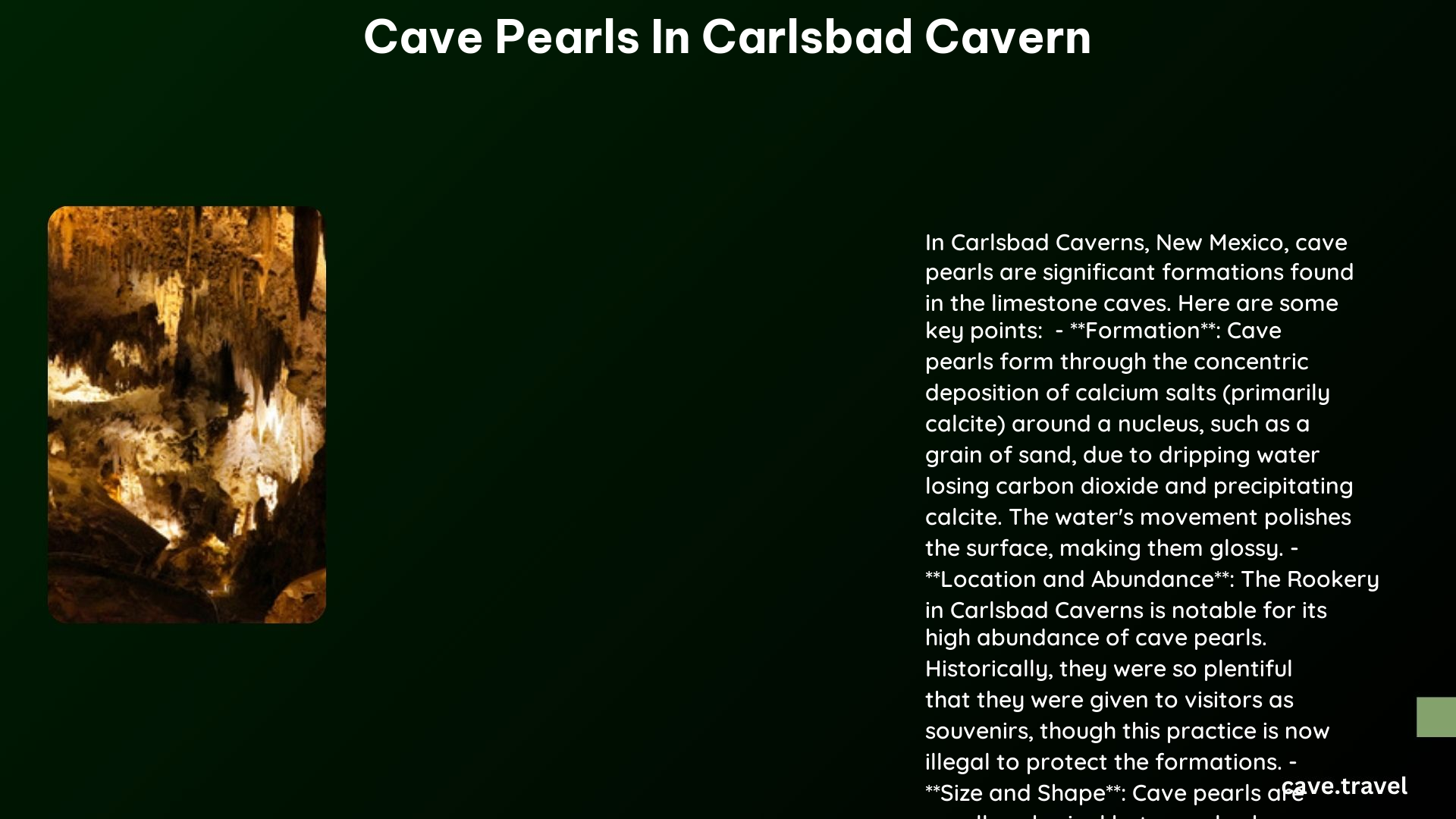Cave pearls in Carlsbad Cavern are fascinating geological formations that captivate visitors with their unique beauty and formation process. These small, spherical concretions of calcite develop in shallow pools within the cave system, created by the continuous dripping of mineral-rich water. The Carlsbad Cavern, located in New Mexico, is renowned for its impressive collection of cave pearls, particularly in an area known as The Rookery. These natural wonders range in size from tiny grains to golf ball-sized spheres, showcasing the intricate processes of mineral deposition and cave formation.
What Are Cave Pearls and How Do They Form?

Cave pearls in Carlsbad Cavern are small, spherical speleothems that form in shallow, agitated pools of water within the cave system. Their formation process is a testament to the delicate balance of geological forces at work in cave environments:
- Water drips into shallow cave pools
- Carbon dioxide is released from the water
- Calcite precipitates around a nucleus (sand grain, bone fragment, etc.)
- Water movement prevents adhesion to the pool floor
- Uniform growth occurs in all directions
This process results in the creation of these unique cave formations that have fascinated scientists and visitors alike for generations.
What Makes Carlsbad Cavern’s Cave Pearls Special?

Carlsbad Cavern’s cave pearls are particularly noteworthy for several reasons:
- Abundance: The Rookery area is famous for its high concentration of cave pearls
- Size Range: Pearls vary from microscopic to golf ball-sized specimens
- Historical Significance: Once given as souvenirs to visitors (now prohibited)
- Preservation Efforts: Subject of ongoing conservation measures
The unique geological conditions in Carlsbad Cavern have created an environment particularly conducive to the formation of these delicate structures, making it a prime location for their study and observation.
What Are the Physical Characteristics of Cave Pearls in Carlsbad Cavern?
The cave pearls found in Carlsbad Cavern exhibit a range of physical characteristics that make them distinct:
| Characteristic | Description |
|---|---|
| Composition | Primarily calcite (calcium carbonate) |
| Surface | Often highly polished due to water movement |
| Shape | Typically spherical, but can be cylindrical, elliptical, or cubical |
| Size | Range from < 1 cm to golf ball-sized |
| Color | Usually white or off-white, but can vary based on mineral content |
These characteristics contribute to the unique appearance and scientific interest in Carlsbad Cavern’s cave pearls.
Where Can Visitors Find Cave Pearls in Carlsbad Cavern?
While cave pearls can be found in various locations throughout Carlsbad Cavern, the most notable area is:
- The Rookery: This section of the cave is renowned for its high concentration of cave pearls. It’s a must-see location for visitors interested in these formations.
Visitors should note that access to certain areas may be restricted to protect these delicate formations. Always follow park guidelines and stay on designated paths.
How Has the Study of Cave Pearls in Carlsbad Cavern Contributed to Science?
The study of cave pearls in Carlsbad Cavern has contributed significantly to our understanding of cave formation processes and mineral deposition:
- Insights into calcite precipitation rates
- Understanding of cave hydrology and water chemistry
- Clues about past climate conditions
- Advancements in speleothem dating techniques
- Improved conservation strategies for cave environments
These scientific contributions highlight the importance of preserving and studying these unique geological formations.
What Are the Conservation Efforts for Cave Pearls in Carlsbad Cavern?
Conservation of cave pearls in Carlsbad Cavern is a top priority for park management. Key efforts include:
- Prohibition of souvenir collection
- Restricted access to sensitive areas
- Educational programs for visitors
- Ongoing monitoring of formation conditions
- Research into preservation techniques
These efforts aim to ensure that future generations can continue to marvel at these natural wonders.
How Do Cave Pearls in Carlsbad Cavern Compare to Those in Other Caves?
While cave pearls are found in various cave systems worldwide, those in Carlsbad Cavern stand out:
- Size: Some of the largest known cave pearls are found here
- Abundance: The concentration in The Rookery is particularly high
- Preservation: Well-preserved due to early conservation efforts
- Accessibility: Relatively accessible for scientific study and visitor observation
These factors make Carlsbad Cavern’s cave pearls a valuable resource for both scientific research and public education.
What Role Do Cave Pearls Play in the Ecosystem of Carlsbad Cavern?
Cave pearls, while seemingly inert, play a subtle but important role in the cave ecosystem:
- Provide microhabitats for cave-dwelling organisms
- Contribute to the overall mineral balance of the cave environment
- Serve as indicators of water flow and chemical composition over time
- Influence the formation of other cave features through their interaction with water flow
Understanding these roles helps scientists and park managers better protect the delicate balance of the cave ecosystem.
How Can Visitors Best Experience Cave Pearls in Carlsbad Cavern?
To fully appreciate the cave pearls in Carlsbad Cavern, visitors should:
- Join guided tours that include The Rookery
- Bring appropriate lighting to observe the pearls’ luster
- Respect all park rules and stay on designated paths
- Participate in educational programs offered by the park
- Consider visiting during off-peak hours for a more intimate experience
By following these guidelines, visitors can enjoy a memorable and responsible encounter with these unique geological formations.
References:
– https://www.nps.gov/subjects/caves/speleothems.htm
– https://en.wikipedia.org/wiki/Cave_pearl
– https://www.britannica.com/science/cave-pearl
